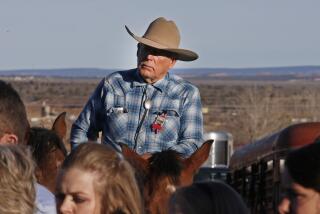‘Freemen’ Surrender, Ending 81-Day Standoff
- Share via
JORDAN, Mont. — The last of the fugitive “freemen” gathered in a quiet circle for a final few minutes of prayer and then surrendered two-by-two into the waiting arms of the FBI late Thursday, peacefully ending an 81-day standoff--one of the longest law enforcement sieges in U.S. history.
Sixteen in all, the men and women rode in cars, pickup trucks and a Winnebago motor home to a cattle guard at the entrance to their compound, where a dozen FBI agents waited with two 15-passenger vans backed up to a gate. The freemen stepped out of their vehicles. They hugged each other.
Soundlessly they gathered and prayed. Finally, at 6:45 p.m. local time, with a surveillance plane circling overhead, their leader, Edwin Clark, approached the FBI and shook hands with an agent standing near the cattle guard. The sun broke through dark clouds shrouding the evening sky. Slowly, Clark returned to his people.
Then, two at a time, he led them off the compound and turned them over to the FBI. Each of the freemen clung to his arms as he walked them forward. After surrendering each pair, Clark turned, walked back to his group and then stepped forward with still another pair. There was no scuffling. Not a shot was fired.
In Washington, FBI Director Louis J. Freeh praised a policy of “patience and resoluteness” that he credited with the outcome. He said the law was enforced “in a way that did not do harm to anyone.” President Clinton told guests at a White House state dinner: “We will all say a little prayer tonight for this peaceful settlement.”
The peaceful surrender contrasted sharply with the bloody resolution of two other sieges conducted by federal agents during the past four years, one near Waco, Texas, and the other at Ruby Ridge in Idaho. It seemed to vindicate the FBI’s new strategy of carefully calibrating pressure on fugitives who have been surrounded and are trying to avoid arrest.
Fourteen of the freemen were believed to be facing charges ranging from threatening a federal judge to being involved in check frauds totaling $1.8 million. The FBI drove them to the Yellowstone County jail in Billings, 175 miles away. The other two freemen were free to go, but the FBI said they would not be allowed to return to the compound.
No handcuffs were in sight as the freemen and the federal agents stepped aboard the two FBI passenger vans and a sedan. Some of the freemen wore cowboy hats. They sat tightly together, side by side, and stared straight ahead as the vehicles carried them 33 miles from the ranch to the small town of Jordan, over a rutted, teeth-rattling dirt road.
Behind the vans rolled a convoy of four-wheel-drive vehicles filled with grinning FBI agents. Some had American flags flying from their radio aerials. Many of the agents waved thumbs-up to reporters and to farm and ranch families standing by the side of the road. Some of the ranchers sipped an occasional beer, enjoying the spectacle.
Ahead of the convoy as it passed through Jordan and arrived in Billings was a large yellow Ryder rental truck. FBI agents had driven it into the compound earlier in the day filled with packing crates, reportedly to remove personal belongings and documents that the freemen say are their evidence of government wrongdoing.
A surrender agreement between the freemen and the FBI reportedly requires Karl Ohs, a Montana state legislator acting as a mediator, to safeguard the documents, which includes information sent to the freemen by supporters from across the nation. Unless the documents were preserved by a third party, the freemen feared that the FBI would destroy them.
The day began with sightings of freemen going to structures within the compound for meetings and then leaving afterward. At one point, they lowered an upside-down American flag at an outpost called Sentry Hill and ran up a Confederate battle flag in its place. At the same time, they abandoned the outpost.
Flying the American flag upside down is a traditional signal of distress, most often used on the high seas. The Confederate flag has a special significance to the freemen. A representative of the group told CNN that it connotes the flag of Jacob, a symbol of the 13 tribes of Israel.
Shortly after the surrender convoy departed, six FBI agents drove to Sentry Hill. One of them pulled down the Confederate flag.
At another point, Clay Taylor, a former freeman, drove into the compound towing a red horse trailer. He returned with two horses. The freemen include hard-luck farmers as well as anti-government extremists. They called the 960-acre ranch that surrounded their compound Justus Township, where they renounced government authority.
When they finally gathered to leave the compound, none of the remaining freemen were minors. Amanda Kendricks, 16, departed the ranch on Wednesday, leaving only adults at the standoff. Two other children and seven adults already had fled.
Hope for an end to the siege rose on Tuesday, when Clark was permitted by the FBI to fly to Billings for a jailhouse meeting with LeRoy Schweitzer, his predecessor as the leader of the group.
After the meeting, however, Schweitzer denied reports that he had agreed to a general surrender. “The quickest way that it could be resolved,” he told ABC News, “is if they’re guaranteed a grand jury hearing. That is what we’ve been asking for over and over again.”
He appeared to be referring to the freemen’s repeated demand for a “common law” grand jury of their own choosing. Authorities have ruled out such a panel, saying it has no legal standing.
Similarly, U.S. Atty. Sherry Scheel Matteucci said the surrender agreement included no provisions for the dismissal or reduction of any charges.
The standoff between the freemen and federal agents started on March 25 when they lured Schweitzer and Daniel Peterson, another freemen leader, outside of the compound.
The agents arrested them.
About 100 agents subsequently surrounded the ranch. For the duration of the standoff, they stayed well away from the compound and kept reporters away as well.
Meanwhile, third-party negotiators, most of them sympathetic to right-wing causes, tried to talk the freemen into surrendering. All but Ohs gave up in frustration. They included such figures as James “Bo” Gritz, a former Green Beret colonel, who ended up disparaging the freemen and their recalcitrance.
Finally, the FBI threatened to shut off electrical power and telephone access to the compound. On June 3, the 71st day of the standoff, the agents began making good on their threats.
The freemen standoff is the longest since at least 1973, when supporters of the American Indian Movement occupied Wounded Knee, the site of a bloody battle during the Indian wars. The FBI placed them under siege. It lasted 69 days, and two AIM leaders were killed.
In 1992, white separatist Randy Weaver held federal agents at bay on Ruby Ridge for 11 days. The standoff began when his son and a federal marshal were killed. Before it ended, Weaver’s wife was shot to death.
A year later, a 51-day standoff between agents and a religious group called the Branch Davidians ended in a fire near Waco. More than 80 people died.
The peaceful surrender of the freemen drew the curtain on a slow minuet pitting the federal agents, fearful of another bloody confrontation, against an odd assemblage of men and women who had sought to use the so-called patriot movement to shield themselves from prosecution.
They were farmers, urban fugitives, racists, religious zealots and tax protesters united under a far-right banner of sovereignty. And for most of the last 2 1/2 months, they were uncompromising, refusing to surrender to local and then federal authorities on a multitude of federal charges.
The freemen’s intransigence brought into sharp focus the social, economic and ideological cross-currents surging throughout the West: farmers and cattle ranchers buffeted by droughts and cyclical markets, intrusive federal land-use policies, racism and defiance of government authority.
But as poster children of the far right, the freemen and their demands ultimately were rejected by some leaders of the patriot movement as irrational and violent. Called “thugs” by some ultra-conservative elected officials, the group was left isolated, facing the prospect of fighting alone for an agenda that local residents learned was tipped with a scorpion’s stinger.
Neighboring farmers were forced off their land by gun-toting freemen. Local officials, many of them relatives of the freemen, were pummeled with specious liens and dead-or-alive bounties. Bogus money orders were deposited in rural Montana banks. Freemen threatened to kidnap and kill a federal judge and hang the county sheriff from a bridge.
Townsfolk in this impoverished Garfield County seat, 100 miles from the nearest major highway and surrounded by sprawling ranches, dun-colored buttes and bone-dry washes bristling with dinosaur bones and sagebrush, eventually pleaded for federal assistance to end a terrifying drama from which there seemed to be no escape.
But hopes for a speedy resolution were short-lived.
Writing a new chapter in the annals of the FBI, agents spent day after day sitting and waiting in four-wheel-drive vehicles and trucks, and sending into the compound intermediary after intermediary--many of whom were initially sympathetic to the freemen but gave up in angry discouragement.
Throughout the ordeal, U.S. Atty. Gen. Janet Reno repeatedly vowed that the potentially explosive dispute would be resolved without bloodshed. The seemingly kinder, gentler approach raised initial fears of strengthening the patriot movement and emboldening anti-government activists in future standoffs.
It became clear nevertheless that the FBI would play by new rules that combined patient negotiation with the steady erosion of sympathy among some of the freemen’s staunchest right-wing supporters.
Instead of ripping apart the freemen compound with armored vehicles and tanks, as it did at Waco, the FBI issued press releases insisting such vehicles were brought in “to protect the safety of the occupants.”
Instead of turning away offers of help from outside negotiators, the FBI invited dozens of them, many of whom came to side with local officials who viewed the freemen as rank opportunists rejected by their community.
Finally, instead of relying on one contingent of agents to manage the siege, the FBI rotated site commanders, SWAT team members and negotiators every few weeks to avoid the mental and physical exhaustion that plagued the standoff at Waco.
Times staff writer Richard E. Meyer in Los Angeles contributed to this story.
More to Read
Sign up for Essential California
The most important California stories and recommendations in your inbox every morning.
You may occasionally receive promotional content from the Los Angeles Times.














